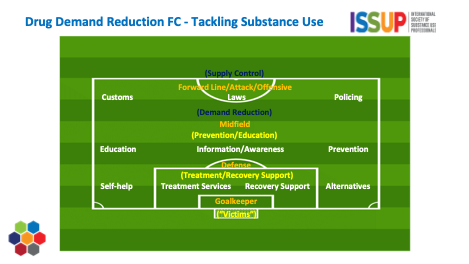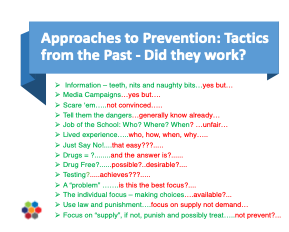It is almost a cliché to state that effective communication is the key to understanding. The dilemma is how to provide effective forms of communication that can be readily understood and ensure the cliché is addressed in action not just words!
The need to communicate a shared understanding regarding prevention, and more specifically prevention related to substance use among the broad range of stakeholders that are “agents of prevention” is a major challenge. Are there different ways to promote an interest and understanding of the issue of prevention? Can we offer other ways of communicating this universal issue to achieve not only a shared understanding but also a commitment to action? This article offers a summary of one alternative way of communicating that might help some “listeners” have a deeper appreciation and understanding of prevention and substance use prevention related issues.
I have worked in more than 90 countries and always felt concerned about my inability to speak any other language fluently amongst the incredible efforts and abilities of those I worked with who were so proficient in speaking English. On one occasion I was working in the United Arab Emirates when I saw a billboard with an advertisement from an international communication company which stated:
I am 1 billion people and 1 common language. Football.
As an avid football follower, this made a lot of sense to me and made me think about how the language of football might be applied to the language of prevention and substance use. Here was a sport played and followed by millions internationally and that might help to overcome cultural, gender and language barriers. I therefore offer some considerations using the language of football that, however imperfect, might help promote an understanding of prevention.
New ways of communicating prevention are particularly relevant in current times. Over the past forty years there have been considerable developments in prevention. We have reached the stage where we have identified prevention as a Science. As such we have also reached a stage in our thinking where we are now accepting the reality that, for example:
- Prevention is a complex issue that requires serious considerations:
- how it should be undertaken?
- where it should take place?
- what do we know doesn’t work?
- who should be involved?
- what we are learning from the research?
- what is “evidence-based prevention”?
- what is the theoretical underpinning for what we do?
- how do we transfer the theory into practice?
- what are the implications for policy?
This article can only offer some initial examples of how the analogy of football might help address a few of the long list of issues confronting prevention and substance use.
A starting point in using the football analogy is how the issue of “drugs” has been traditionally addressed within the terminology of “drug supply control and demand reduction”. I therefore offer the idea of the “Drug Supply Control and Demand Reduction Football Club” and how that team operates.
Traditionally the concern has been about “illegal drugs” rather than the broader concept of drugs or substances. Increasingly any discussion of “drugs”, particularly with respect to prevention, includes all psychoactive substances, be they legal or illegal and includes those drugs, such as tobacco and alcohol, which can cause more problems to individuals’ health and to society generally than illegal substances.

The “forward line” has its focus on trying to control the supply of drugs reaching the country and the potential drug user. The effort is concentrated on policing, the role of customs and the application of laws to identify and stop drugs reaching their intended destination. This “forward line” or “attack” is the one that costs most money to the team as it has been proposed that the “goals scored” by the attack through drug seizures is money well spent. The question however is whether this well-resourced part of the team is truly cost effective? It may score several “goals”, but how many does it miss, and which result in the pressure and stress on the rest of the team? It has the backing of the police, the law and order community and governments, but there are serious questions as to whether it is sufficient on its own, and whether it is cost and practically effective.
Generally, the next part of the team which receives attention is the “defence”. In the defence, the focus is on reducing the demand for drugs, and how we can help those with substance use disorders. In the defence we find the positions taken by treatment, recovery support and self-help. Funding is increasingly being found to form a good defence but does not match the levels of the funding for the strikers in the team’s attack of “supply control”. The treatment response has changed over the years. Until relatively recently it meant punishment as the way to address the issue. Even today this is the response within many government policies and can often result in significant punitive responses. However, over recent years there has been a move away from seeing substance use as a law and order issue and more of a public health issue. The individual using substances is acknowledged as suffering from an addiction or a “disease” that requires an appropriate, long-term response similar to that provided to any other chronic illness. It is no longer the role of the defence to just kick the ball anywhere which often results in it being quickly returned. The approach recommended is to treat the ball sensitively and effectively, developing a positive, evidence-based move out of defence into “recovery support”. This is seen as much more likely to result in retaining control of the game and a goal being scored.
The “midfield” is the part of the team that has not been given the attention it deserves or requires if the “team” is to be effective and achieve its objective: scoring goals, winning matches, to be successful and ultimately top of the “League Table”. From the drug use terminology, this objective is generally acknowledged as aiming to avoid the harm that drug/substance use can cause with a focus on delaying onset of use and avoiding the use of certain substances. It is also increasingly accepted that the focus should be on all psychoactive substances including legal and illegal drugs, prescribed and over the counter medication, and other synthetic, manufactured substances.
The midfield comprises the contribution of education, prevention and promotion of health and well-being. The midfield is usually regarded as the “engine room” of a football team. It links the attack and defence. It scores and saves goals. It allows a cohesive, coordinated team effort for addressing and achieving the team’s objective. The other reality is that the midfield receives less attention than the attack or midfield. It is less glamorous and less likely to provide the photo opportunity of a goal being scored or a save on the line. It receives less money and investment. Again, change is in the air as the role and contribution of the midfield is increasingly recognised as necessary and effective. The evidence for this is growing. In most countries there will be agreement that “prevention is better- and cost-effective - than cure”. However, this is still slow in being translated into practice, and to funds and action for the team to perform as it could on the pitch.
We have outlined what constitutes our “drug demand reduction/supply control football team” as it plays in countries around the world. New thinking, approaches and tactics are being proposed based on evidence and experience, but the old policies and performances remain heavily reliant on the traditional modus operandi of the three key sections of our team. It is important to remember that it is a team and that it still needs to function that way, whilst considering how that team plays, including each role of “attack”, “defence” and “midfield” to achieve maximum impact.
The football analogy can be used for other aspects of addressing prevention and the issue of substance use. Prevention “tactics” are an essential part of the team’s preparation to become effective, such as appropriate methodology, multi-disciplinary engagement, relevant policies, etc. It is also important to stress those tactics that are not appropriate to an evidence-based approach to “substance use prevention football” such as using scare tactics or lecture/information focussed inputs.

An important element of prevention through the football analogy is to allow consideration of the skills, competencies, expertise, and experience required for a professional to be considered a “preventionist”. They are the “specialisms” required in prevention with respect to substance use. This consideration of the players encourages a formation that comprises competencies required within the team. The objective is to address what and who is required in a professional and evidence-based approach to prevention if it to have a chance of success in addressing “the cause”.
The potential of using the football analogy to help communicate an understanding of prevention with respect to substance use is, of course, imperfect and cannot be applied to all we need to address in our work in this area of need. However, it may offer an opening of the door for some – or a goal being scored - towards better communication and understanding of what we need to address. Therefore, we try to apply the learning required for developing and implementing effective evidence-based prevention. If so, it has proved its worth!
The knowledge and understanding gap between researchers and practitioners existed and remains, and the football link occurs again! I can only hope it allows us to score a few more goals and climb the League Table to ensure prevention is not only a matter for words but an issue that requires action!
Jeff Lee
Senior Consultant - ISSUP
December 2022